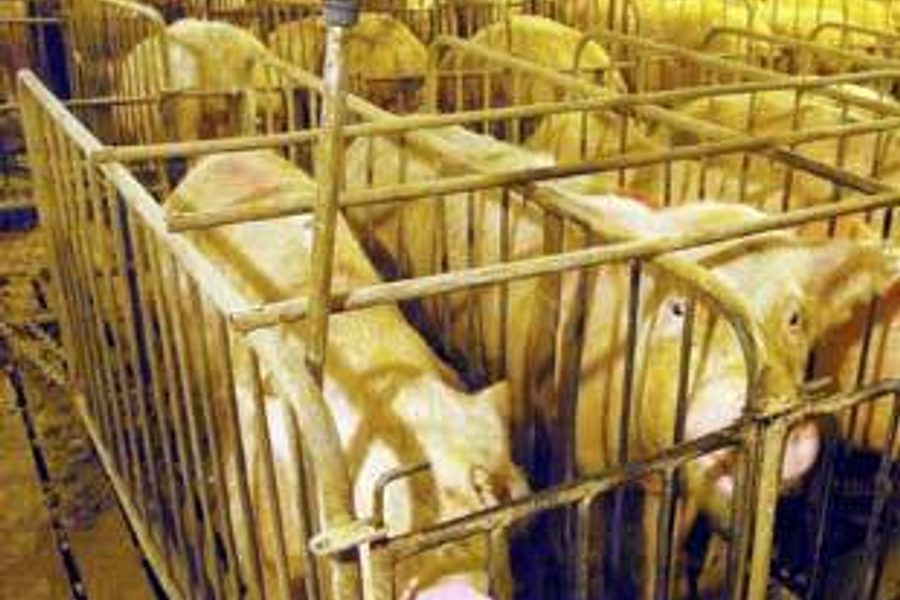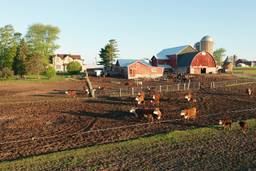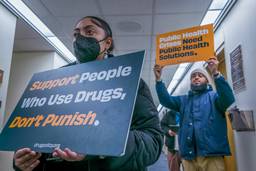Environmental Hogwash
The EPA works with factory farms to delay regulation of ‘Extremely Hazardous Substances.’
Christopher D. Cook

Chicken has taken on a whole new meaning for Faye Lear, of White Plains, in western Kentucky, who lives 300 feet from two giant barns containing thousands of birds laying eggs for Tyson Foods.
There are the sickening wafts of ammonia and bird feather dust that chase her inside from her front porch. Clouds of well-fed flies swarm her car windows. Once a year, when the barns are emptied for cleaning, mass infestations of mice overrun the neighborhood.
“It’s like an open sewer for a big city,” says Lear, who works as a nurse. “It’s nauseating, it burns your eyes. I wouldn’t call them a farm — they’re like an industry.”
Across the country, thousands of these “factory farms” — each warehousing thousands of tightly confined hogs, chickens or cows — produce potentially toxic air emissions. These fumes are the byproduct of 1.3 billion tons of waste created annually by the sprawling compounds, which are the top polluters of America’s waterways according to the Environmental Protection Agency (EPA).
Despite this torrent of manure, and a growing number of lawsuits by sickened neighbors, “there are essentially no pollution controls on these operations whatsoever,” says Sierra Club attorney Barclay Rogers. “The environment is being wrecked by these operations.”
But the EPA isn’t ready to stanch this stench anytime soon. According to documents obtained by the Sierra Club through a Freedom of Information Act request, the EPA has developed a voluntary air monitoring program in close collaboration with animal-industry groups such as the National Pork Producers Council (NPPC) and the US Poultry and Egg Association. (The cattle industry chose not to participate.)
The plan, still being hashed out internally at the agency “resolves [participating companies’] civil liability for potential violations” of federal clean air laws. In effect, this would mean a two-year amnesty from enforcement of the Clean Air Act — as well as immunity from federal Superfund and environmental right-to-know laws. During this time, some of the nation’s largest pig and chicken facilities would gather air emissions data. Only later could they be penalized for exceeding the emmissions limits for ammonia and hydrogen sulfide.
Environmentalists are up in arms. “The exchange of data for prosecutorial immunity is antithetical to the notion of aggressive environmental enforcement,” says Rogers.
“These [poultry] operations are generating extraordinary quantities of ammonia gas,” says Rogers. Ammonia gas is listed as an “Extremely Hazardous Substance” in the Superfund law and is a key contributor to particulate matter pollutants. Indeed, EPA researchers have found that “animal husbandry operations” are responsible for 73 percent of all ammonia released into the air nationwide.
In 2001, EPA inspectors detected disturbingly high releases of ammonia from Buckeye Egg Farm in Ohio, then the nation’s fourth-largest egg producer. Some Buckeye facilities were churning out 700-800 tons of particulate matter per year — far in excess of the federal air-quality reporting standard of 250 tons. After years of enforcement battles begun under the Clinton administration, the EPA this past February secured a Clean Air Act settlement and a $880,598 civil penalty against the now-defunct Buckeye.
A 1999 analysis of air data by the Environmental Defense Fund found that hog operations spew 167 million pounds of ammonia nitrogen into the atmosphere each year in North Carolina alone. “Studies in the North Carolina region where hog facilities are clustered show that the level of ammonia in rain has doubled in the past decade,” the report stated.
Epidemiological studies, meanwhile, suggest the fumes may cause increased rates of asthma, chronic bronchitis and other respiratory disorders. A 1999 report prepared by epidemiologist Steve Wing for the North Carolina Department of Health and Human Services found that people residing near a large hog facility suffered increased levels of nausea, diarrhea and respiratory problems.
The livestock industry dismisses such information. “There has not been anything scientifically proven that these hog barns would cause any ill to human beings,” says Kara Flynn, director of communications for the NPPC. “I travel routinely to hog farms and I’ve never smelled anything that caused me any grief … it’s actually very pleasant, surprisingly, fairly normal.” Flynn says, “We are paying for that study to take place so that they [EPA] can … come up with regulations that impact us. I think that’s more than fair.”
The EPA — citing a 2002 National Academy of Sciences report calling for further study — insists that it needs more information before it can enforce the law. “A lot of people assume we know the quantity and type of emissions coming from these [animal feeding operations] and we don’t,” says EPA Press Secretary Cynthia Bergman. Rather than going after companies one by one, says Bergman, “a better way is to figure out what their emissions are industrywide.”
But critics say the Bush administration’s EPA has dragged its feet and stifled the momentum of factory-farm enforcement begun under President Clinton. Michele Merkel, a former EPA staff attorney now working with the Washington DC-based Environmental Integrity Project, says the agency “hasn’t initiated one investigation in four years. They’re not doing anything.”
Most distressing, says Merkel, is that the EPA has spent years negotiating a voluntary “safe harbor” approach when the agency has long had the “authority to gather the kind of data it needs to determine emissions levels at these industrial farming operations. It doesn’t need industry’s permission. It doesn’t need to sign up to this voluntary agreement. They’re privatizing a rulemaking process.”
Environmentalists call the EPA plan a “sweetheart” deal between the Bush administration and the livestock sector, which contributed $3.46 million to candidates for federal office in 2004, 79 percent of it to Republicans, according to the Center for Responsive Politics.
Indeed, on September 16 the NPPC presented its “Friend of the Pork Producer” award to President Bush, citing his “tireless efforts to use reason and science in shaping environmental policies impacting agriculture.”
Now Senator Larry Craig (R-Idaho) is preparing legislation to exempt industrial farms from federal Superfund and right-to-know laws altogether, potentially rendering the EPA plan moot. A coalition of 33 family farm and environmental groups is lobbying hard to block the rider.
Christopher D. Cook is an award-winning investigative reporter who also writes for Harper’s, The Atlantic, The Guardian, Mother Jones, and the Los Angeles Times. He is the author of Diet for a Dead Planet: Big Business and the Coming Food Crisis. Connect with him via www.christopherdcook.com.








